
The increasing variety of Google's SERPs sometimes feels intimidating for SEO professionals and business owners alike, but it all comes with advantages as well.
The bright side is, with all the SERP variety, there are now lots of other ways to gain additional exposure in search; the ultimate goal of SEO may no longer be getting the first blue link.
Being featured as an answer to People Also Ask (PAA) questions is a good opportunity to get ahead of your competition and catch the interest of your target audience.
So let’s see how People Also Ask results evolved, and how you can research and optimize for PAA to increase your SEO visibility in Google.
What is Google’s People Also Ask?
People Also Ask boxes are a dynamic SERP feature, containing sets of questions related to the original search query.
Most likely, you have seen one of these in search results before:

Once a question is clicked, the box expands to display a text snippet with a brief answer to the question. It also shows the URL for the text source and a shortcut link for performing another Google search for that question.

Extra questions are added once you click on a result.
Initially, a People Also Ask box contains a set of four questions, but with each click on a question, two or three additional questions are added to the PAA box. PAA boxes are therefore ever-expanding, with new questions being infinitely added to the box.
Let's delve into why these questions should be an important part of your SEO strategy.
Why is People Also Ask important?
Ever since April 2015, when Google first tested PAAs in search results, the number of SERPs with these results have increased massively. Most of that increase has been in the last couple of years, turning this feature into a valuable opportunity for businesses to increase their visibility in search results.
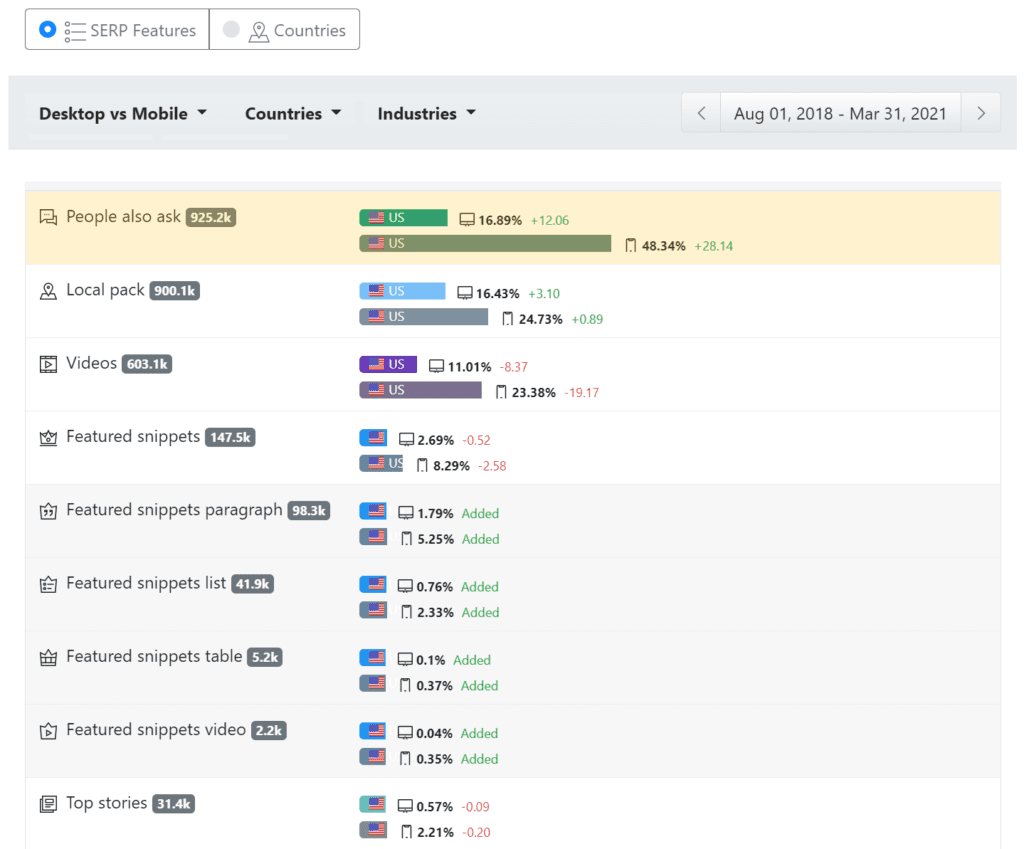
People Also Ask has increased by 200% since August 2018
As the most recent research shows, in the UK, the percentage of PAA boxes has increased by 200% since August 1, 2018, even after a drop in early March 2020.
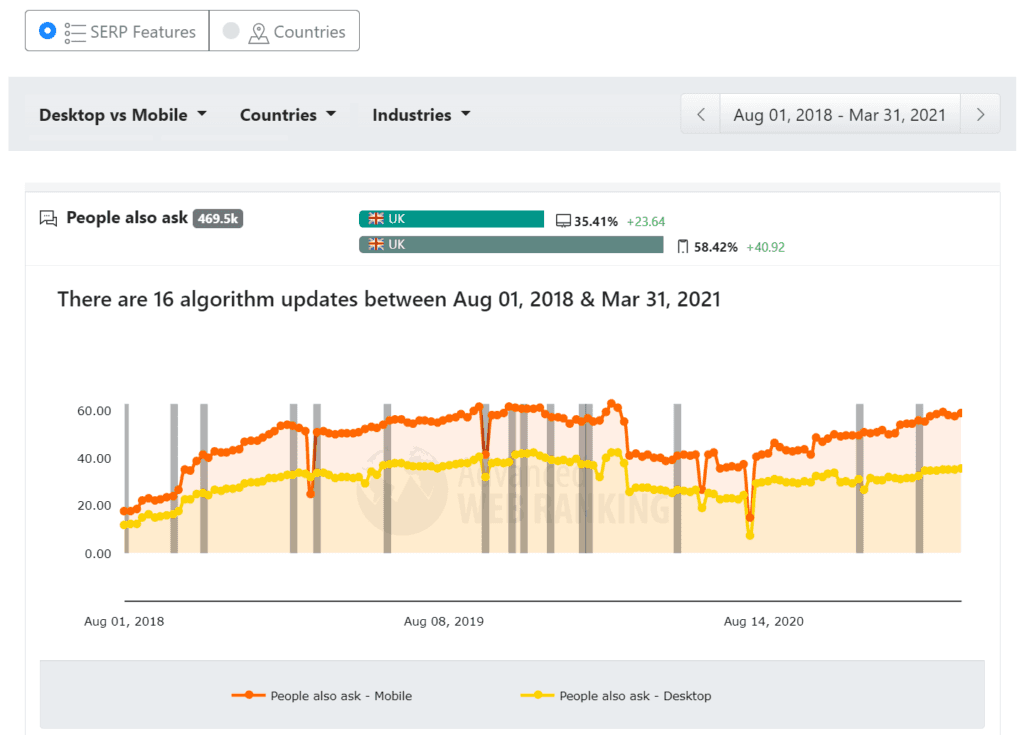
Research data is available for free, through Advanced Web Ranking’s SERP Features Tool.
PAA boxes show up in nearly 35% of all UK SERPs
This one stat on its own should make you realize why you should be taking them seriously.
Thirty-five percent is a huge figure, making it the most common SERP feature there is in UK SERPs.
Here is an overview of the UK SERP features currently shown on Google, and the percentage of SERPs they show up on:
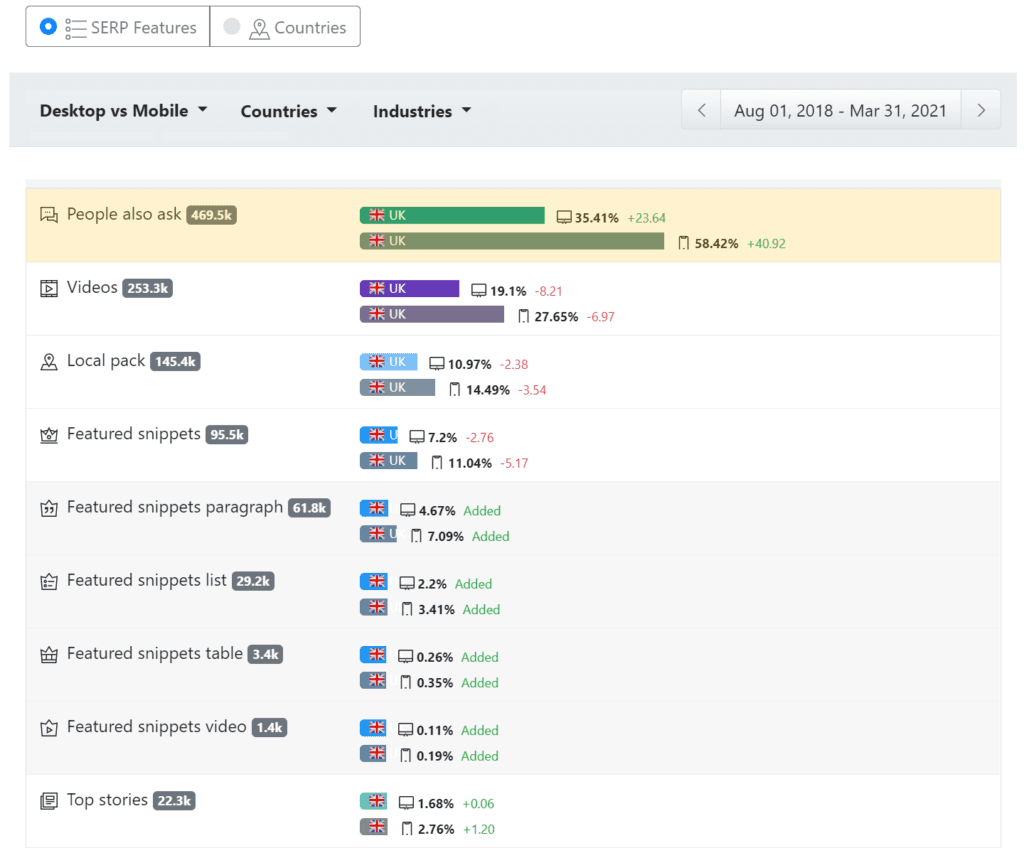
PAA frequency is higher on mobile than on desktop
The percentage of SERPs with PAA results is much higher on mobile devices. In the United States, they appear three times as often on mobile than on desktop; in Singapore, they appear almost twice more often in mobile results.
This may not come as a surprise since most of us spend more time on mobile devices. Most likely Google wants to save users time in typing on mobile and make sure they have fast-loading results. This helps the user experience and makes people want to use Google for mobile.
So if your site needs to be more mobile-friendly, that could help you get featured by Google and increase your visibility in the search results. Make sure to check out our Mobile SEO Guide to step up your optimization process.

Most countries see an increase in People Also Ask
While the UK is the leading country with the highest percentage of queries containing PAA results for desktop searches, substantial increases of PAA results have been seen in the past year for most of the countries included in the study:
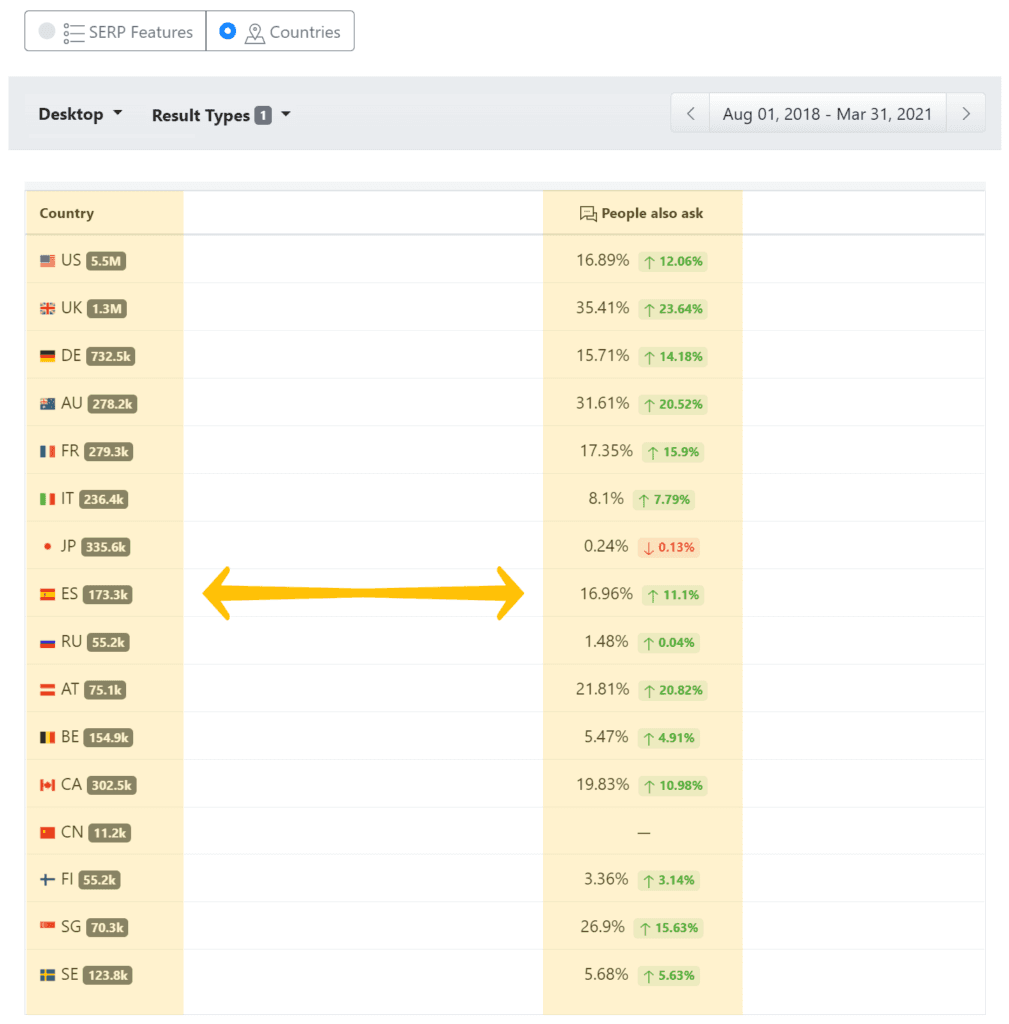
There is a higher number of SERPs with PAA in most countries tracked. You can find more stats on PAA and all the other types of results through Advanced Web Ranking’s SERP Features Tool. No login required.
PAA frequency is different by country
The frequency of PAA results is different from one country to another, with the UK, Australia, and Singapore leading for desktop searches.
This means that you need to do some research before deciding if it’s worth adding it to your SEO strategy. More on this research later in the article.

If your country doesn’t have a high frequency for PAA in our dataset, that doesn’t mean that you shouldn’t look more into it.
For mobile devices, UK and Singapore continue to lead the charts, while Australia drops from the top three and the United States moves up a few positions to the third position.

In conclusion, PAA frequency has increased over recent years. It appears more often on mobile and it varies by country, so you need to do your research before deciding on resources that should be assigned to optimizing for this type of SERP feature.
Do your targeted keywords trigger People Also Ask questions?
But more than the global stats, it’s critical to know if the keyword set you’re targeting has potential for People Also Ask optimization.
To get started with this analysis, head over to your rank tracking tool, and see the frequency of PAA results for your target phrases.
For Advanced Web Ranking, make sure you’re using the Google Universal search engine ranking data, and look at the SERP Features report under Competitive Intel:
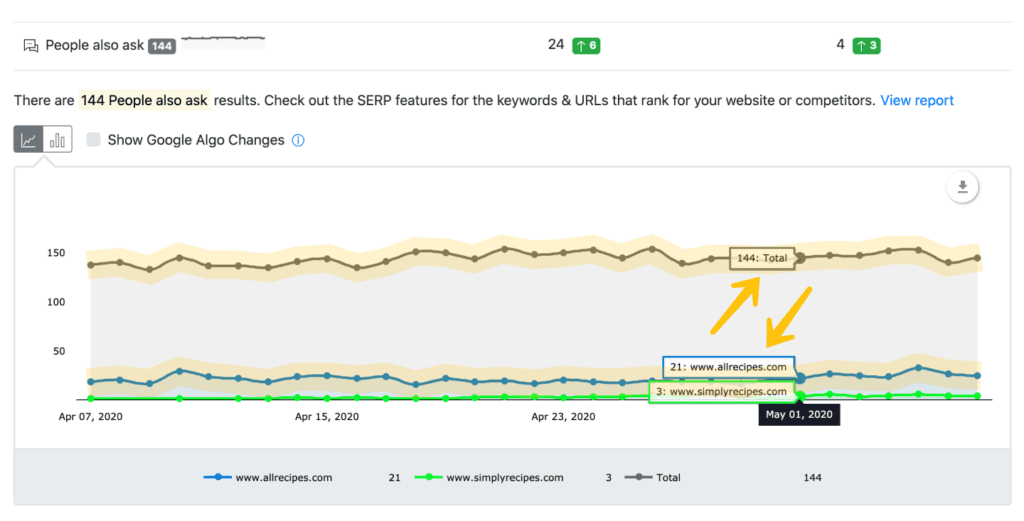
The total number of PAA results triggered by your keywords vs. the PAA results that you or your competitors own. Screen from Advanced Web Ranking’s Competitive Intel > SERP Features report.
In the example above, there’s plenty of room for improvement, with only 21 PAA boxes the main website (allrecipes.com) being included in, out of the total 144 PAA boxes triggered. This means that there is potential to optimize the content and rank for more results.
To segment the data further and pin down those opportunities for appearing in more PAA results, you need to look at the keywords that trigger PAA questions for which you are not yet listed for and evaluate your chances to improve your positioning.
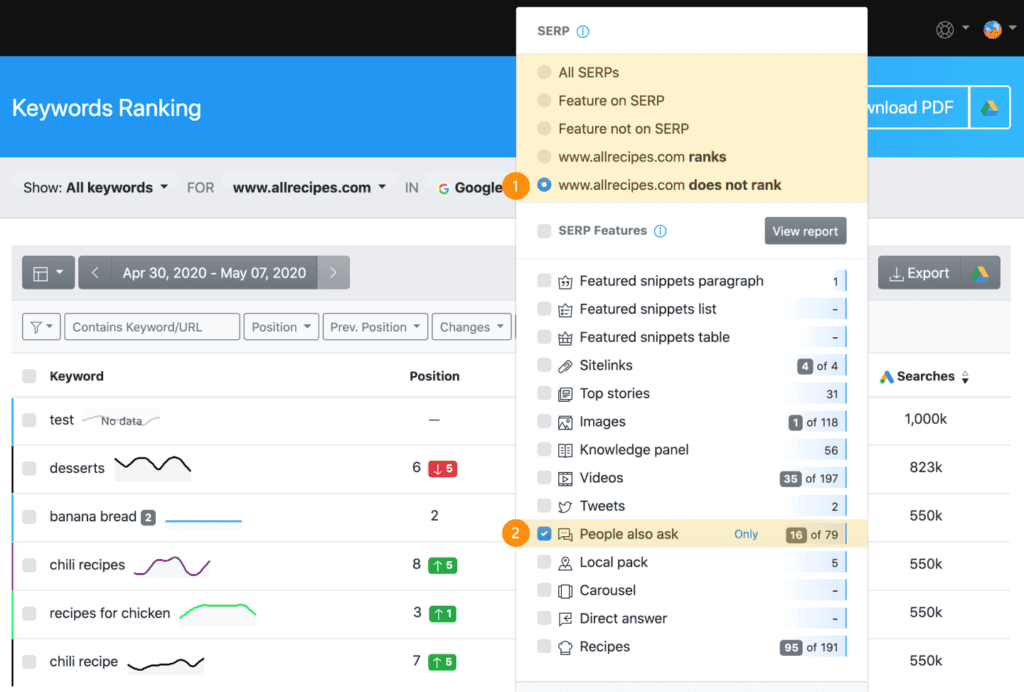
How to research PAA questions for your targeted keyword set
If targeting People Also Ask questions seems profitable for your niche, you’ll want to research what questions are showing up in the SERPs that you are focusing on.
For this, you’ll need a bit of spreadsheet work, but nothing too difficult.
With Advanced Web Ranking, just pull the Top Sites rankings for your entire keyword set, and filter People Also Ask results out from the rest.

Use the Export function in the Advanced Web Ranking Top Sites report, to get this data and then filter by PAA. In our example, we found over 1500 PAA questions we can target.
Once you have the list of PAA questions included in SERPs for your keyword set, all you have to do is to make sure your content is addressing these questions and is optimized for PAA boxes.
If you don’t have enough data in your Advanced Web Ranking account just yet, you could use tools like AlsoAsked or AnswerThePublic for researching questions that you can target with your content.
How to optimize content for People Also Ask
Google generates PAAs using its algorithm, so there is no dedicated markup available for getting included in SERPs as answers to PAA questions.
However, we are not left clueless on what’s needed for a page to be considered for PAA. There are a few suggestions on which industry professionals have agreed on that influence PAA answers:
Provide short, but complete questions and answers
Write in plain, non-salesy, language
Write content with the questions you found during research in mind.
We can also pull insights from the connection noticed to exist, in many cases, between PAA and Answer Boxes (AKA Featured Snippets).
If you look at the answers included in People Also Ask boxes, it’s very likely the same snippet that will appear as Answer Box for the search queries corresponding to each question.
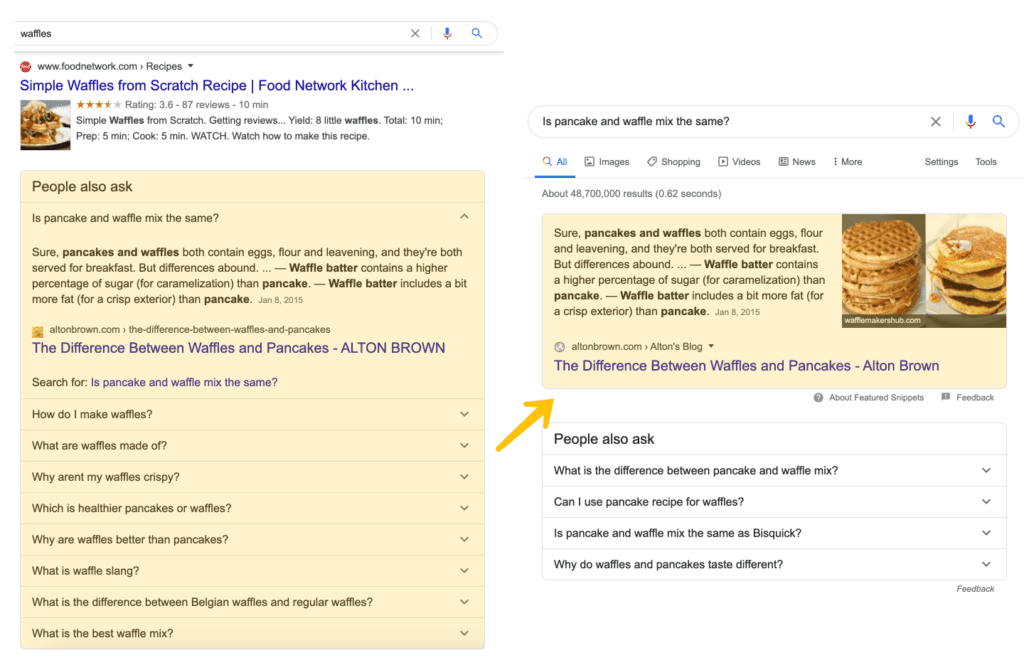
The People Also Ask answer becomes a Featured Snippet when you search for that particular question.
In these cases, we can assume the rules that apply to Feature Snippet optimization also apply to PAA.
How to track People Also Ask rankings
In the “Keywords Ranking” report, you can use the “SERP Features” filter to get a list of terms for which you’re currently ranking inside PAA boxes.
Start by segmenting your keyword data by “My Site” ranks + “People Also Ask”.

Keywords where Google listed your webpages as People Also Ask answers.
Often, the position reported for each keyword and URL will not reflect the PAA’s position. This happens when the URLs included in PAA are also ranking organically for that term, making it impossible to record two positions for the same URL/keyword combination.
When that happens, the SERP analysis report in Advanced Web Ranking shows the highest position in SERP, organic, or PAA.
To check the exact page URL ranking as PAA and the questions included in the PAA box, you’ll want to go to the Top Sites report:
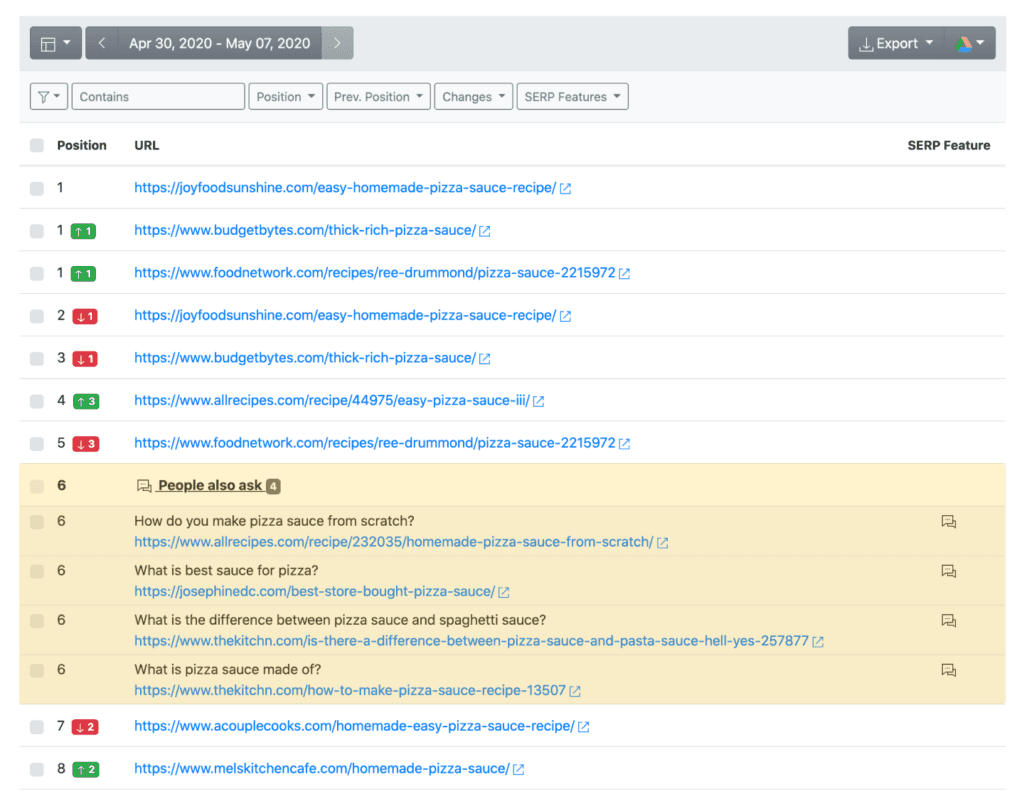
People Also Ask questions and URLs for your keywords.
Check it out
Ok, enough about what People Also Ask, let me also ask you some questions 😀.
How much SEO effort do you put into this SERP feature, and how do you approach ranking higher for PAAs? I would love to hear your thoughts on this.
And don’t forget to give Advanced Web Ranking a try if you haven’t done that already. It’s free for 30 days.




